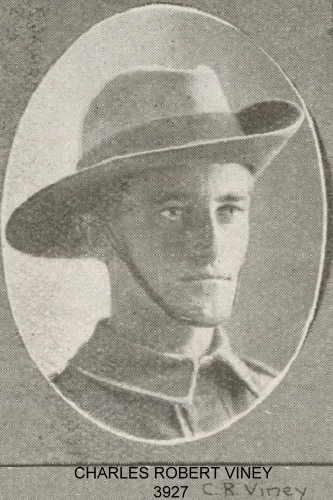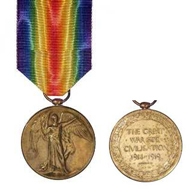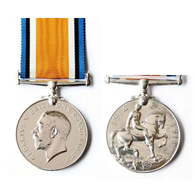VINEY Charles Robert
-

- 3927
- Private
- 47 Battalion
- 15th Battalion
- Cooroy
- Yes
- about June 1889
- Cadock, east Cape Colony, South Africa
- 2 April 1915
- HMAT A23 Suffolk
- 30 November 1915
- Sydney
-
Family
Charles Robert Viney was born in Cradock, eastern Cape Colony, South Africa in about June 1889, the son of Henry Stephen and Julia Viney.
Military Context
The 47th Battalion was raised in Egypt on 24th February 1916 as part of the doubling of the AIF. About half of its recruits were Gallipoli veterans from the 15th Battalion and the other half were fresh reinforcements from Australia. Reflecting the composition of the 15th, the 47th was composed mainly of men recruited in Queensland and Tasmania. The new battalion was incorporated into the 12th Brigade of the 4th Australian Division.
Arriving in France on 9 June 1916, the 47th entered the trenches of the Western Front for the first time on 3 July. It participated in its first major battle at Pozieres. Initially, the battalion provided working parties during the 2nd Division’s attack on 4 August, and then, with its own division, defended the ground that had been captured. The 47th endured two stints in the heavily-contested trenches of Pozieres, as well as a period in reserve.
After Pozieres, the battalion spent the period up until March 1917 alternating between duty in the trenches and training and rest behind the lines. On 11th April it took part in the attack mounted against the heavily defended village of Bullecourt. Devoid of surprise, and dependent upon the support of unreliable tanks, the attack failed. Later in the year, the focus of the AIF’s operations switched to the Ypres sector in Belgium where the 47th took part in the battles of Messines and Passchendaele.
Enlistment
Charles Robert Viney presented at Cooroy and signed his enlistment papers at Enoggera on 2 April 1915. He stated that he had been born at Cradock, Cape Colony, South Africa. His age was recorded as 26 years 5 months and occupation as “clerk”. He was unmarried. Charles listed his father Henry Stephen Viney, Box 197, Johannesburg as his next of kin.
At enlistment, his height was 5 feet 7 inches, weight 136 pounds, of fair complexion, blue eyes and auburn hair. His religion was Church of England. His service number was 3927.
Private Viney’s service commenced with the 11th Depot Battalion at Enoggera. He was allotted to the 12th Reinforcements to the 15th Battalion. Private Viney embarked at Sydney on HMAT A23 “Suffolk” on 30 November 1915, bound for Egypt. He was taken on strength of the newly formed 47th Battalion at Tel el Kebir on 9 March 1916.
Military Service
Charles Viney’s service was characterised by frequent indiscipline/punishment, and periods of mental/physical debility. It should be noted that, although there was one occasion when he was absent without leave during his three months of service in Egypt, the worst of his indiscipline came after he had been exposed to a period of intense warfare on the Western Front, was rendered unconscious by a shell explosion, and was evacuated to England suffering from shell shock.
On 25 April 1916, at Serapeum, he was absent without leave for 3½ days for which he forfeited a total of ten days of pay. On 2 June 1916, he proceeded to join the British Expeditionary Force in Europe. He departed Alexandria aboard the Transport Ship “Caledonia” and disembarked at Marseilles on 9 June.
On 7 August 1916, in the fighting at Pozieres, Private Viney was rendered unconscious by a shell blast. He was transported to 44th Casualty Clearing Station at Puchevillers and diagnosed as suffering from “shell shock”. He was moved on 140 kilometres to the 14th Stationary Hospital at Boulogne. On 17 August, he was evacuated on Hospital Ship “Cumbria” to England. Next day, he was admitted to the 3rd London General Hospital at Wandsworth.
During the early stages of WW1, soldiers from the B.E.F. began to report medical symptoms after combat, including tinnitus, amnesia, headache, dizziness, tremor, and hypersensitivity to noise. While those reporting sick showed no signs of head wounds, the symptoms resembled those that would be expected after a physical wound to the brain. By November 1914, as many as 10% of British officers and 4% of enlisted men were suffering from “nervous and mental shock”. In the case of Private Viney, there had been a specific event that would have left him with severe concussion but, for unfortunate others, their symptoms were often dismissed as “lack of moral fibre”. A century later, there is recognition that “combat stress reaction”, as called in World War II, and now “traumatic stress disorder” is a real and common risk for all soldiers in combat.
On 13 October 1916, Private Viney was admitted to the 3rd Australian Auxiliary Hospital at Dartford. By 23 October when he was discharged to Wareham, the medial record showed “Present condition good. Sleeping well”. He was granted furlough and ordered to report back to the No.1 Command Depot at Perham Downs on 7 November. On 9 November, his medical condition was assessed as B.1.A. (“fit for garrison duty and able to march, see to shoot, hear well and stand active service conditions”) and he was marched out to No. 4 Command Depot at Wareham. On 24 November, his medical record showed he was complaining of “insomnia”.
On 11 December 1916, he went absent from Wareham without leave. He did not return until 8 January 1917. He was placed in custody until his trial on 25 January. His punishment, awarded by Lieutenant Colonel Roberts, was 73 days’ forfeiture of pay and 28 days of Field Punishment No.2.
On 23 February 1917, he was charged with having been absent overnight for 7½hours. Patience with Private Viney was wearing thin. He was held in custody for 8 days awaiting trial on 3 March before Major Shaw. He forfeited 10 days of pay. During his custodial period, he neglected to obey Depot orders and incurred another day of detention on 5 March before Captain Herbert.
On 12 March 1917, at Wareham, Private Viney again went absent and not until 12 April was he apprehended by military police in London. He was held in custody for 14 days awaiting trial, and then was awarded 20 days of detention and 66 days forfeiture of pay (equivalent to sixteen pounds sterling), again by Lieutenant Colonel Roberts.
On 3rd June 1917, he proceeded to Folkestone and thence to France. He joined the 4th Australian Division Base Depot at Etaples on 5 June. On 22 June, he marched out to join his unit in the field in Belgium.
On 13 July, he reported sick to 13th Field Ambulance with a “stricture of urethra” (he had four years previously suffered from gonorrhoea) . Next day, he was transferred to the 32nd Stationary Hospital at Wimereux. He was evacuated to England and admitted to the 2nd Military Hospital, Canterbury on 22 July. On 30 July, he was transferred to the 3rd Australian Auxiliary Hospital at Dartford. He was immediately granted furlough, with orders to report to Training Depot at Perham Downs on 14 August. He failed to report.
When he finally appeared on 10 September, he was held in custody for three days before his trial. There he was awarded 25 days detention and total forfeiture of 56 days of pay by Lieutenant Colonel Knox. On 17 September 1917, at No.1 Command Depot Perham Downs, Private Viney’s medical assessment was reviewed to “C1 - permanently unfit for general service but fit for home service”. It was assessed that he would require surgery.
On 8 October 1917, he was marched out to the No.2 Command Depot at Weymouth to prepare for return to Australia. . Return to Australia
On 1 November 1917, Private Viney embarked at Devonport on Hospital Transport A68 “Anchises”. He disembarked at Melbourne on 3 January 1918.
On 18 March 1918, Private Viney was discharged from the A.I.F. at Brisbane. Two weeks earlier, A.I.F. Administrative Headquarters in London had received a request from Julia Viney at 121 Loveday St., Wanderers View, Johannesburg, Transvaal, South Africa. She asked that her son be advised of the death of his father. “We do not know his address since he returned disabled to Australia about two months ago. We sent him to war over three years ago and he was anxious to go well and hearty and he has returned ill and very much knocked about. It is very hard having just lost his father. We are naturally very upset”. The drafting of a reply was delegated to Base Records in Melbourne.
On 5 August 1918, Mrs Viney was moved to write again to Base Records in Melbourne: “With reference to letter posted some time ago from London, we got a letter from my son Charles R. Viney. In April last, we do not even know if he knows of his father’s death as I his mother am half blind so please excuse all mistakes. This has only occurred since Mr. Viney’s death. Oh please tell me all the news you can. My poor heart is broken. We write to this address for my son Charlie – c/- General Post Office, Brisbane. Please dear sir would you be so kind as to let me know all news as soon as you can as I am wretched and half blind and so very miserable so please be good and kind to me in my great sorrow. Thanking you deeply for all your kindness to me. I remain respectfully and most gratefully.” By now, the woman was c/- Mrs Shadford at her previous Johannesburg.
Very sadly, Charles Viney died in 1920, aged only 30 years. His death was registered in Camden, NSW. On 16 September 1920, the “Camden News” carried the news of the monthly meeting of the Camden Sub-branch of the Returned Services League. The meeting “endorsed the actions of the Executive Committee in arranging the proper internment of the late Charles Viney (late A.I.F.) and having the Sub-branch meet all the expenses involved”.
On 4 August 1927, the Camden Sub-Branch of the Returned Services League wrote to Base Records seeking Private Viney’s details of battalion and regiment. The league wished to erect a headstone on the man’s grave at Camden cemetery. The Base Records Office promptly replied with the service information and details of next of kin in South Africa but noted that this was the first advice it had received that the man was deceased.
-
- Egypt
- Pozieres
- Western Front
-

-

- Returned to Australia
- Disembarked from HMAT A68 "Anchises" at Melbourne on 3rd January 1918
- 1920
- Camden, New South Wales
- 30 years
- Camden, New South Wales
-
Shire of Noosa Roll of Honor, Shire Council Chambers, Pelican Street, Tewantin
-
Australian War memorial
National Australia Archives
Ancestry.com
Trove digitalised newspapers - Charlie50
